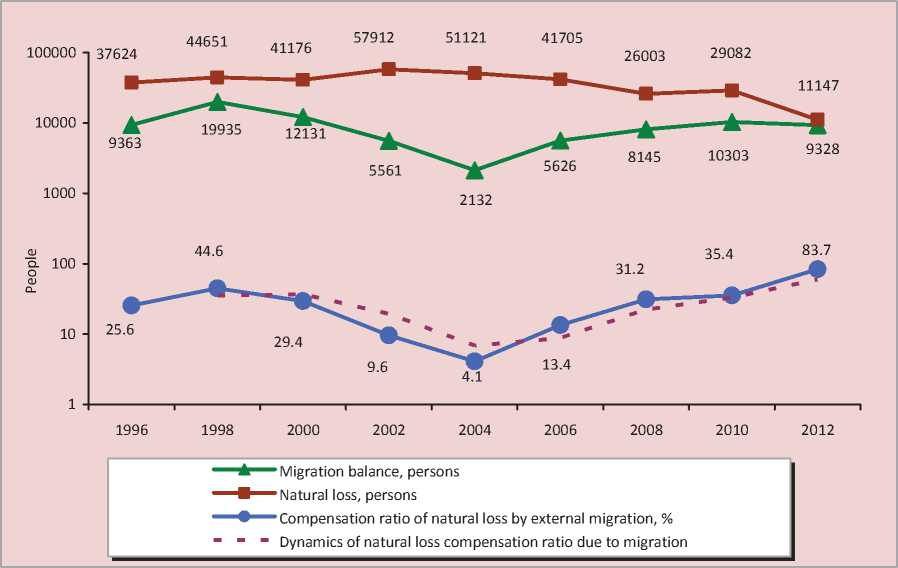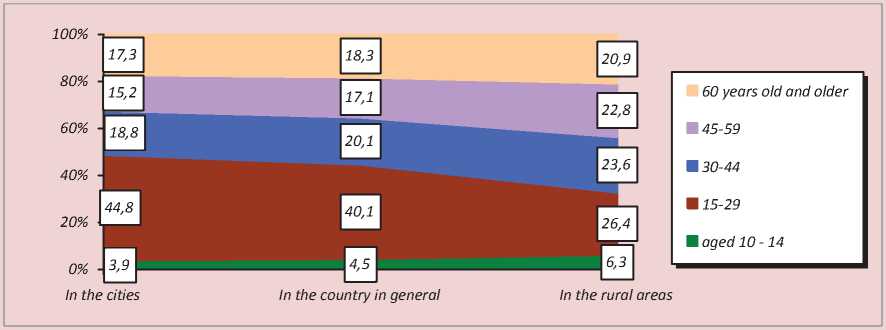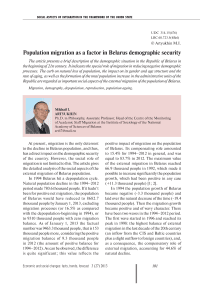Population migration as a factor in Belarus demographic security
Автор: Artyukhin Mikhail Ivanovich
Журнал: Economic and Social Changes: Facts, Trends, Forecast @volnc-esc-en
Рубрика: Social aspects of integration in the framework of the Union State
Статья в выпуске: 3 (27) т.6, 2013 года.
Бесплатный доступ
The article presents a brief description of the demographic situation in the Republic of Belarus in the beginning of 21st century. It indicates the special role of migration in reducing negative demographic processes. The curb on natural loss of population, the impact on its gender and age structure and the rate of aging, as well as the formation of the total population increase in the administrative units of the Republic are regarded as important social aspects of the external migration of the population of Belarus.
Migration, demography, depopulation, reproduction, population ageing
Короткий адрес: https://sciup.org/147223464
IDR: 147223464 | УДК: 314.15(476)
Текст научной статьи Population migration as a factor in Belarus demographic security
At present, migration is the only deterrent to the decline in Belarus population, and thus, has a direct impact on the demographic security of the country. However, the social role of migration is not limited to this. The article gives the detailed analysis of the social aspects of the external migration of Belarus population.
In 1994 Belarus hit a depopulation cycle. Natural population decline in the 1994–2012 period made 780.6 thousand people. If it hadn’t been for positive net migration, the population of Belarus would have reduced to 8682.7 thousand people by January 1, 2013, excluding migration processes (or 16.5% as compared with the depopulation-beginning in 1994), or to 9310 thousand people with zero migration balance. As of January 1, 2013 the factual number was 9463.3 thousand people, that is 153 thousand people more, considering the positive migration balance of 9.3 thousand people in 2012 (the amount of positive balance for 1994–2012). As can be observed, the difference is quite significant; this value reflects the positive impact of migration on the population of Belarus. Its compensating role amounted to 15.4% for 1994–2012 in general, and was equal to 83.7% in 2012. The maximum value of the external migration in Belarus reached 66.9 thousand people in 1992, which made it possible to increase significantly the population growth, which had been positive in any case (+11.3 thousand people) [1; 2].
In 1994 the population growth of Belarus became negative (-3.3 thousand people) and laid over the natural decrease of the time (-19.4 thousand people). Then the migration growth became positive and of wavy character. There have been two waves in the 1994–2012 period. The first wave started in 1996 and reached its peak in 1998: the highest balance of external migration in the last decade of the 20th century (an inflow from the CIS and Baltic countries plus a slight outflow to foreign countries), and, as a consequence, the compensatory role of external migration, accounting for 44.6% of natural decline.
Then the stage of the wave decay comes. The minimum fell for 2004: positive migration balance amounted to 2.1 thousand people and the rate of natural decline was one of the highest in the past two decades (-57912 people in 2002). As a result, in 2004 the compensatory role of migration was the lowest for the two decades (4.1%, except for 1994, when she was absent at all) (fig. 1) .
But the migration inflow, as well as migration balance was declining. The absence of a comprehensive national migration policy was the main reason for the reduction in the inflow in the second half of the 1990s.
The second wave of the migration impact on the demographic processes occurred in other conditions. The Programme on the Socio-economic Development of the Republic of Belarus for 2001–2005, the National Demographic Security Programme of the Republic of Belarus for 2007–2010, the
National Demographic Security Programme of the Republic of Belarus for 2011–2015 had been adopted. But the main thing is that the generation of the demographic rise of the late 1980s reached the reproductive age. This led to a significant reduction in natural losses (up to 11147 people in 2012). The number of departures from the Republic reduced (up to 9328 people in 2012 against 13812 in 2000) [3-6, 12].
In 2012, the natural loss of Belarus population amounted to 11147 people, the positive balance of migration was 9328 people, compensatory role of migration reached 83.7%. However, considering that the second wave of migration growth is approaching its peak, the wave decay is likely to begin soon, as the prerequisites for this exist. According to the Belarusian demographer L.P. Shakhotko, in the first decade of the 21st century the sex-age structure of Belarus population contributed
Figure 1. Compensation ratio dynamics of the natural loss of Belarus population due to external migration in 1996–2012, with the use of logarithmic scale. [comp. 2, 3, 4, 5, 6, 12]

to the increase in the number of births and the reduction in the number of deaths. But as thin cohorts of those, born in the 1990s, will be reaching the active reproductive age, their number will start declining rapidly. It will adversely affect the dynamics of children born in the country in the second and third decades of the 21st century. As the people born after the war will reach the retirement age, the number of deaths will increase [2].
It should be acknowledged that the state authorities got an understanding of the migration role in the ensuring of the demographic security of the Republic. Upon the implementation of the economic growth and migration attractiveness, 33 thousand of foreign citizens were temporarily employed in the country and 13 thousand were attracted to Belarus as full-time residents in 2010. More than 3.5 thousand ethnic Belarusians have acquired the citizenship [7]. The National Demographic Security Programme of the Republic of Belarus for 2011–2015 have been adopted. It stipulates the increase in the positive migration balance within 60 thousand people in 5 years up to 2015, including 10 thousand people in 2011, 11 thousand people in 2012, 12 thousand people in 2013, 13 thousand people in 2014, 14 thousand people in 2015 [8].
According to the authors, such migration volume is insufficient to overcome the depopulation of Belarus. The National Demographic Security Programme of the Republic of Belarus for 2011–2015 points out the necessity to reduce population decline up to 18.5 thousand people in 2011, up to 15 thousand people in 2012, up to 9 thousand people in 2013, up to 4 thousand people in 2014, and to ensure minimum positive natural growth in 2015. In order to stabilize the demographic situation, large-scale compensatory immigration, based on a differentiated approach to various categories of migrants, with regard to national interests, is necessary on the one hand, and the preservation and enhancement of its own population (reduced mortality and increased birth rate), on the other hand. To stop population decline, it is necessary to ensure the so-called ‘zero option’, assuming the full coverage of natural loss by migration growth. The ‘zero option’ in the context of Belarus implies the positive migration balance of about 28–30 thousand people per year (the real rate of natural loss amounted to 25.7 thousand in 2011 and decreased to 11.2 thousand only in 2012) or 140–150 thousand people in total for 5 years, i.e., in fact, the entire volume of net migration for the 1994–2010 period. It is difficult to achieve these numbers in such a short period taking into account the existing demographic trends, since the total real indicator for 2006– 2010 amounted to 40999 people, and 23887 people for 2001–2005 [2, 3, 4, 5, 6].
During 1996–2000 the indicator made 73.6 thousand people, but migration policies have not yet been developed then, therefore the opportunity to keep the pace was missed out. Obviously, it is impossible to increase the inflow from 10.3 thousand in 2010 up to 30 thousand people per year, this can be only achieved gradually, as the socio-economic conditions in Belarus will be improving, which is rather problematic in the conditions of global financial and economic crisis. However, there are objective prerequisites for improving the quantitative indicators of the total inflows. A significant migration potential of Belarus in the CIS countries and abroad still remains.
Thus, according to 2009 data, 814.7 thousand Belarusians live in Russia, 600 thousand in the USA, 275.8 thousand in Ukraine, 200 thousand in Canada, 130 thousand in Israel, 96 thousand in Latvia, 95 thousand in Kazakhstan, 55 thousand in Lithuania, 50 thousand in Poland, 21 thousand in Estonia, 20 thousand in Moldova, 20 thousand in Australia, 7 thousand in Argentina, 7 thousand in Great Britain, 2 thousand in Belgium [9]. Mixed families, one or more members of which are ethnic Belarusians, as well as migrants who have relatives in the Republic of Belarus fall into the category of potential migrants in the first place.
Currently, there are two major factors contributing to the return migration of the Belarusians to the Republic of Belarus from the former Soviet republics: a) stable political situation; b) the status of the Russian language as the state language alongside with the Belarusian language. The mobility of the indigenous ethnic groups of the CIS and Baltic States is quite low, however, due to the considerable number of Russian citizens (about 140 million people); the migration potential is quite significant and can be oriented at the Republic of Belarus.
The realization of the migration potential of the Belarusian diaspora and the indigenous population of the CIS and Baltic States depends on the socio-political and economic situation prevailing in these states, as well as the current migration policy. An adequate national migration policy can contribute to the return of a sufficient number of compatriots from the CIS and countries outside the former Soviet Union back to Belarus. Belarus may, to some extent, resolve the problem of shrinking population in the midterm, as well as obtain qualified labour resources by attracting migrants from the CIS countries. The migration of the population from the CIS countries can address at least two tasks: gradual levelling of depopulation; the provision of the stability of the population and the transition to a zero growth.
The influx of migrants from the CIS countries should not be considered as a threat to the titular nation for three reasons: firstly, the number of immigrants is relatively smaller than the number of Belarusians (7 957 252 people according to 2009 population census); secondly, the demographic situation will gradually stabilize, and in the long term the Belarusian population will be able to reproduce on an extended basis; thirdly, Belarus has never been a purely mononational country, such as Japan, the traditions of different peoples, living together on the same territory, are strong and still remain.
However, migration is not only partially levels population natural loss, but also has a positive effect on its age structure. At present, it is important for Belarus to slow down the ageing of the population. Clearly, if the senior citizens prevail in the immigrant structure, it will reinforce the deformation of the age pyramid of Belarus population, i.e. aggravate the current situation. Vice versa, the prevalence of young persons in the immigrant structure contributes to the increase in labour resources of the Republic, as well as working-age people in general and plays an important role in the adjustment of the population age structure.
The last population census of the Republic of Belarus, conducted in 2009, allowed identifying the age structure of the migrants, who arrived in the country in the 2005–2009 period (fig. 2) .
The situation is the following: individuals aged 15–29 years made up 40.1% of the migrants who arrived in the Republic in the 2005–2009 period. It is a very positive and advisable fact for replenishing demoreproductive potential of Belarus and to adjust the age structure of its population, however it is nonhomogeneous. As follows from fig. 2, the major share in this process is played by the migrants, arriving to the city (people aged 15–29 years made up 44.8% of the arrived) constitute the major share in the process.
The bulletin column ‘working-age population’ [10] shows that the working age population prevails both in the flow of migrants, who have arrived in 2005–2009 in the cities (75.4%), and in the flow of migrants, who have arrived in 2005–2009 in the rural areas of Belarus (67.9%). At the same time, 43.7% of those, who arrived in 2005–2009 in the rural areas, were people aged 45 and older, on the verge or exceeding both the working and reproductive ages.
Figure 2. Age structure of migrants, arrived in the Republic of Belarus in 2005–2009 [comp. by 10]

Thus, the external migration most thoroughly ensures the decrease in the pace of aging only of Belarus urban population, and practically has no effect on the decline in the pace of ageing and on the adjustment of the sex and age pyramid in the rural areas.
The latter determines the goal of improving the state immigration policy, which cannot be limited only to the solution of the displaced persons issue and the creation of an emigration control system, and should be aimed at the regulation of migration flows, in order to improve the demographic and socio-economic situation in Belarus. The programme on the attraction and resettlement of labour migrants and their resettlement is to be coordinated at national and regional levels. Regions may initiate targeted programmes to draw migrants, particularly labour migrants. Moreover, local budgets are also to be involved in the implementation of these programmes.
Given the fact that the migration policy of Belarus must contribute to the current and future economic and demographic needs of the country, the measures on selective immigration policy (the attraction of young people and highly skilled work force to solve problems of innovation development of the country and regions) should be elaborated starting from now.
Thus, based on the conducted research, it can be concluded that external migration plays an important role in the development of Belarus as a factor: 1) containing natural loss of the population of the Republic; 2) changing the age and sex structure and rates of aging of both urban and rural population; 3) forming the total increase of the population of the administrative units of the Republic of Belarus.
In general external migration acts for the Republic as a factor stabilizing the population and contributing to the creation of conditions for its further growth. Following 2011, one can expect some reduction in mortality, and, probably, a certain rise in birth rates but only in case of economic recovery and improving health service. It is advisable to facilitate the increase in migration volumes. Under such condition, the prerequisites will be created for the growth of Belarus population as a key factor in achieving socio-economic development and enhancing national security.
Список литературы Population migration as a factor in Belarus demographic security
- Shakhotko L.P. Migration processes and their role in solving demographic security issues of the Republic of Belarus. Human potential of the Republic of Belarus. Minsk, 2009
- Shakhotko L.P. The Model of the demographic development of the Republic of Belarus. Minsk, 2009.
- Main results of the migration of the population of the Republic of Belarus: statistical digest. Minsk, 2008.
- Main results of the migration of the population of the Republic of Belarus for January-December of 2009: statistical digest. Minsk, 2010.
- Main results of population migration and external labour migration in the Republic of Belarus for January-December of 2010: statistical digest. Minsk, 2011.
- Main results of the migration of the population of the Republic of Belarus for January-December of 2011: statistical digest. Minsk, 2012.
- The national security concept of the Republic of Belarus. Minsk, 2011.
- The National Demographic Security Programme of the Republic of Belarus for 2011-2015. Available at: http://mintrud.gov.by/min_progs/prog22/
- How are you doing, Belarusian diaspora? Belarus time: online newspaper of the Embassy of the Republic of Belarus in the Russian Federation. Available at: http://www.belarustime.ru/belarus/culture/diaspore/c6420f28d9870602.html
- The migration of the population of the Republic of Belarus: statistical bulletin. 2009 Belarus census materials. Minsk, 2011.
- On natural movement of the population of the Republic of Belarus in 2010. Minsk, 2011.
- Main results of the migration of the population of the Republic of Belarus for January-December of 2012: statistical digest. Minsk, 2013.


